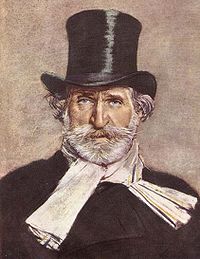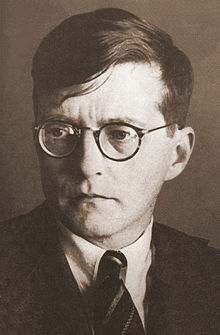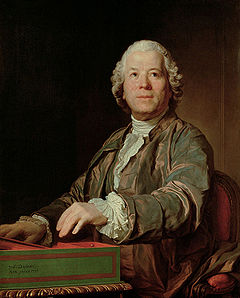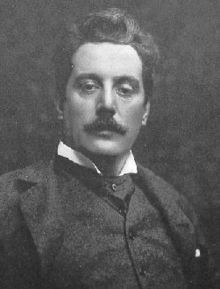- List of major opera composers
-
This list provides a guide to the most important opera composers, as determined by their presence on a majority of compiled lists of significant opera composers. (See the "Lists Consulted" section for full details.) The composers run from Jacopo Peri, who wrote the first ever opera in late 16th century Italy, to John Adams, one of the leading figures in the contemporary operatic world. The brief accompanying notes offer an explanation as to why each composer has been considered major. Also included is a section about major women opera composers, compiled from the same lists. For an introduction to operatic history, see Opera. The organisation of the list is by birthdate.
Contents
1550–1699
- Jacopo Peri (1561–1633). A Florentine who composed both the first opera ever, Dafne (1598), and the first surviving opera, Euridice (1600).[1]
- Claudio Monteverdi (1567–1643) is generally regarded as the first major opera composer.[2] In Orfeo (1607) he blended Peri's experiments in opera with the lavish spectacle of the intermedi.[3] Later, in Venice in the 1640s, he helped make opera a commercially viable form with Il ritorno d'Ulisse in patria and L'incoronazione di Poppea, one of the earliest operas in the present-day operatic repertoire..
- Francesco Cavalli (1602–1676). Amongst the most important of Monteverdi's successors, Cavalli was a major force in spreading opera throughout Italy and also helped introduce it to France. His Giasone was " the most popular opera of the 17th century".[4]
- Jean-Baptiste Lully (1632–1687). In close collaboration with the librettist Philippe Quinault, Lully founded the tradition of tragédie en musique,[5] combining singing, dance and visual spectacle, which would remain the most prestigious French operatic genre for almost a hundred years. Cadmus et Hermione (1673) is often regarded as the first example of French opera.
- Henry Purcell (1659–1695). Purcell was the first English operatic composer of significance. His masterwork is Dido and Aeneas.[6]
- Alessandro Scarlatti (1660–1725). A key figure in the development of opera seria, Scarlatti claimed to have composed over 100 operas, of which La Griselda is a notable example.[7]
- Jean-Philippe Rameau (1683–1764) was the most important French opera composer of the 18th century. Following in the genre established by Lully,[8] he endowed his works with a great richness of invention. Rameau's musical daring provoked great controversy in his day,[8] but he was an important influence on Gluck.
- John Gay (1685–1732) and Johann Christoph Pepusch (1667–1752). Creators of the first English ballad opera, the biting political satire, The Beggar's Opera.[9]
- George Frideric Handel (1685–1759). Handel's baroque-era opera serias set the standard in his day.[10] Despite the often stifling conventions of opera seria, Handel composed a series of over 30 operas that continue to fascinate audiences today. His masterwork is generally thought to be Giulio Cesare.
1700–1799
- Giovanni Battista Pergolesi (1710–1736). Though Pergolesi also composed opera serias, his most influential work was the short opera buffa, La serva padrona.[11]
- Christoph Willibald Gluck (1714–1787) was a key figure in the transformation of Baroque into Classical opera, paving the way for Mozart, though his influence stretched much further into the 19th century, with both Berlioz and Wagner acknowledging their debt to him. In his reform operas from Orfeo ed Euridice onwards, he sought to throw off the formal conventions of opera seria and write music of "beautiful simplicity" (his own words)[12] which would concentrate on the drama rather than musical virtuosity for its own sake.
- Domenico Cimarosa (1749–1801). Italian composer most famous for the opera buffa, Il matrimonio segreto, which forms a bridge between the comedies of Mozart and Rossini.[13]
- Wolfgang Amadeus Mozart (1756–1791). Drawing heavily on the reforms of Gluck, Mozart's series of comic collaborations (Così fan tutte, Don Giovanni, and The Marriage of Figaro) with Lorenzo da Ponte are among the most popular operas in the repertoire today,[14] along with his Singspiel The Magic Flute.
- Luigi Cherubini (1760–1842). A follower of Gluck, Cherubini's most famous opera is Médée. The title role has proved a challenge to sopranos (including Maria Callas) since its premiere in 1797.[15]
- Ludwig van Beethoven (1770–1827) wrote only one opera, Fidelio, a tale of freedom from political oppression, which has become one of the major German language operas.[16].
- Gaspare Spontini (1774–1851). Though Italian, Spontini is best known for his work in France during the Napoleonic era. His masterpiece La vestale influenced Bellini and Berlioz.[17]
- Daniel-François-Esprit Auber (1782–1871). French composer celebrated for high-spirited opéra comiques such as Fra Diavolo and Le domino noir. His grand opera La muette de Portici attained unexpected political influence when a performance in Brussels in 1830 sparked off a revolution which led to the creation of Belgium.[18]
- Carl Maria von Weber (1786–1826) founded German Romantic opera[19] in order to challenge the dominance of Italian bel canto. A master of orchestral colour and atmosphere, Weber was never well served by his librettists, and only one of his works, Der Freischütz, is performed with any frequency. Though he died young, his influence on later German composers, especially Wagner, was immense.
- Giacomo Meyerbeer (1791–1864). The archetypal composer of French grand opera, Meyerbeer's huge extravaganzas such as Les Huguenots and Le prophète were immensely popular in their day.[20]
- Gioachino Rossini (1792–1868) links bel canto with Grand Opera. His immortal Barber of Seville was the only one of his operas that was continuously performed into the 20th century,[21] but his serious operas, such as Semiramide and Ermione, are recognised as masterpieces now that singers with appropriate technique are again available to perform them. Guillaume Tell, his swan-song, has a vast sweep[21] only equalled in the 19th century by the later works of Verdi, Mussorgsky and Wagner.
- Gaetano Donizetti (1797–1848). Along with Rossini and Bellini, Donizetti is generally acknowledged as one of the masters of the bel canto style. His masterwork is generally cited as being Lucia di Lammermoor.[22]
- Jacques Fromental Halévy (1799–1862). Along with Meyerbeer, the best known composer of French grand opera, Halévy's key work is La Juive, a story of religious intolerance set in 15th century Germany.[23]
1800–1849
 Giuseppe Verdi, by Giovanni Boldini, 1886 (National Gallery of Modern Art, Rome).
Giuseppe Verdi, by Giovanni Boldini, 1886 (National Gallery of Modern Art, Rome).
- Vincenzo Bellini (1801–1835). On account of such works as Norma and I puritani, Bellini is now recognised as one of the leading composers of the bel canto style of opera.[24]
- Hector Berlioz (1803–1869). Berlioz's attempts to carve out an operatic career for himself were thwarted by an unimaginative musical establishment.[25] Nevertheless, he managed to produce Benvenuto Cellini, Béatrice et Bénédict and his masterpiece, the epic Les Troyens,[26] the only French opera of its era of sufficient magnitude to challenge the music dramas of Wagner. Berlioz's dramatic legend, La damnation de Faust, has also been staged as an opera in recent years.
- Mikhail Glinka (1804–1857) founded the Russian operatic tradition with his historical drama A Life for the Tsar and his fairy tale piece Ruslan and Lyudmila.[27]
- Ambroise Thomas (1811–1896). French composer noted for the operas Mignon and Hamlet.[28]
- Richard Wagner (1813–1883). Wagner revolutionised opera. In a series of "music dramas" such as Tristan und Isolde, Parsifal, and most of all his epic tetrology Der Ring des Nibelungen, Wagner abolished the traditional distinction between recitative and aria and pioneered a new through-composed style of opera that avoids traditional cadences. Famous for their gigantic scale, Wagner's works also initiated a move away from traditional tonality.[29]
- Giuseppe Verdi (1813–1901) had a long composing career, during which his compositional style kept evolving. Among his most famous works are Rigoletto, Il Trovatore, La traviata, Don Carlos, Aida, and Otello. Mocked by critics during his lifetime and even today as melodramatic, Verdi's operas today dominate the world's stages.[30]
- Charles Gounod (1818–1893) wrote lyrical operas on literary themes, including Roméo et Juliette and Mireille. His Faust was one of the most popular operas ever written and still holds the stage today,[26] in spite of criticisms of its "Victorianism".
- Jacques Offenbach (1819–1880) was the founder of French operetta and a prolific composer of pieces which achieved tremendous success with Parisian audiences for their catchy melodies and satirical bite such as La vie Parisienne and Orpheus in the Underworld.[31] At the time of his death, Offenbach was working on a more serious opera, The Tales of Hoffmann.
- Bedřich Smetana (1824–1884) established Czech national opera with such historical epics as Dalibor.[32] His folk comedy The Bartered Bride has entered the international repertory.
- Aleksandr Borodin (1833–1887). A "weekend composer" who spent 17 years working on a single opera, Prince Igor, which now forms a key part of the Russian repertory.[33]
- Camille Saint-Saëns (1835–1921). French composer of around a dozen operas of which one, the Biblical Samson et Delila, has an assured place in the repertoire.[34]
- Léo Delibes (1836–1891). French composer, whose Lakmé is notable for its Flower duet and as a vehicle for coloratura sopranos.[35]
- Georges Bizet (1838–1875). Bizet's masterwork Carmen is a staple of the repertoire of opera houses the world over. At the time of its premiere, the controversial plot scandalised both critics and the public.[36]
- Modest Mussorgsky (1839–1881). Mussorgsky completed only one opera, but Boris Godunov proved to be inspiration for generations of Russian composers on account of its uniquely nationalist character.[37]
- Pyotr Ilyich Tchaikovsky (1840–1893). Tchaikovsky's international fame as an opera composer mainly rests on two works, Eugene Onegin and The Queen of Spades.[38] Less interested in cultivating a uniquely Russian style than his contemporary Mussorgsky, Tchaikovsky also shows the influence of Mozart, bel canto and Bizet's Carmen in these pieces.[39]
- Emmanuel Chabrier (1841–1894) had ambitions to write grand operas in the Wagnerian vein, but is now most celebrated for lighter pieces, such as L'étoile and Le roi malgré lui, which were greatly admired by Ravel and Poulenc.[40]
- Antonín Dvořák (1841–1904) was the leading Czech opera composer between Smetana and Janáček. His Rusalka, based on the Undine legend, is his most popular work internationally.[41]
- Jules Massenet (1842–1912). Arguably the most representative French opera composer of his era (the Belle Époque), Massenet was a prolific and versatile writer whose works cover a wide variety of themes.[42] His popularity faded somewhat after the First World War, but Werther and Manon still make regular appearances in the opera house.[43]
- Nikolai Rimsky-Korsakov (1844–1908). Russian composer who wrote colourful operas on legendary and historical subjects.[44]
1850–1899
- Leoš Janáček (1854–1928). Janáček's first mature opera (Jenůfa) blended folksong-like melodies and an emphasis on natural speech-rhythms à la Mussorgsky with a character-driven plot of some intensity;[45] his later works became increasingly terse, with recurrent melodic fragments, lyrical outbursts and unconventional orchestration serving a diverse collection of source-material – just a few bars of these operas can instantly be identified as his.
- Ruggero Leoncavallo (1857–1919) Italian composer associated with verismo. His Pagliacci is a staple of the operatic repertoire and is usually given alongside Mascagni's Cavalleria rusticana.[46]
- Giacomo Puccini (1858–1924). The only true successor to Giuseppe Verdi in Italian opera,[47] Puccini's Tosca, La Bohème and Madama Butterfly are among the most popular and well-recognised in the repertoire today.
- Gustave Charpentier (1860–1956). French composer famous for a single opera, Louise, set in a working class district of Paris.[48]
- Claude Debussy (1862–1918). Like Beethoven, Debussy finished only one opera, but his setting of Maeterlinck's Symbolist play Pelléas et Mélisande is a key work in 20th century music drama.[49] In many ways an "anti-opera", Pelléas contained little of the conventional singing or action audiences at the première had come to expect, but Debussy used his subtle orchestration to create an elusive, dream-like atmosphere, which still has the power to fascinate (or repel) listeners today.
- Pietro Mascagni (1863–1945). Italian composer, famous above all for Cavalleria rusticana, usually given in a double-bill with Leoncavallo's Pagliacci.[50]
- Richard Strauss (1864–1949). Strauss was one of very few opera composers in the early years of the 20th century to accept and conquer the challenge laid down by the scale and radical nature of Wagner's innovative works.[51] He composed several operas that remain extremely popular today, including Salome, Elektra, and Der Rosenkavalier.[37]
- Hans Pfitzner (1869–1949). A follower of Wagner, Pfitzner is best known for the opera Palestrina which explores the debate between tradition and innovation in music.[52]
- Arnold Schoenberg (1874–1951). A leading Modernist composer and the deviser of the twelve-tone system, Schoenberg began his operatic career with the Expressionist monodrama Erwartung. His major opera Moses und Aron was left unfinished at his death.[53]
- Maurice Ravel (1875–1937) wrote two short, but innovative, operas: L'enfant et les sortilèges, set in the world of childhood, and the Spanish-flavoured L'heure espagnole.[54]
- Franz Schreker (1878–1934). An Austrian composer associated with Expressionism, Schreker once rivalled Richard Strauss in popularity but, as a Jew, he fell foul of the Nazis. His operas include Der ferne Klang and Die Gezeichneten.[55]
- Igor Stravinsky (1882–1971). After composing the Rimsky-Korsakov-inspired The Nightingale and the near-operas Renard and The Soldier's Tale, Stravinsky bucked 20th century trends by composing a "number" opera, The Rake's Progress, using diatonicism.[56]
- Alban Berg (1885–1935). Because of their atonal music which uses tonal conventions harkening back to late romanticism[57] and tragic libretti, Berg's masterworks Wozzeck and Lulu have stayed in the repertory and assumed increased popularity after his death.[58]
- Béla Bartók (1881–1945) wrote only one opera, Duke Bluebeard's Castle, a key piece in 20th century music theatre and the only Hungarian work with a secure place in the international operatic repertoire.[59]
- Sergei Prokofiev (1891–1953). A major modern composer in the Russian tradition,[60] Prokofiev produced operas on a wide variety of subjects, from the comic fairy-tale The Love for Three Oranges, to the dark and occult The Fiery Angel and the epic War and Peace. Like Shostakovich, Prokofiev suffered under the Soviet artistic regime, but his work has recently been championed by conductors such as Valery Gergiev.
- Paul Hindemith (1895–1963). A German composer who came to prominence in the years following World War I. His key opera Mathis der Maler, dealing with the problems of an artist in a time of crisis, has been seen as an allegory of Hindemith's situation during the Third Reich.[61]
- George Gershwin (1898–1937) owes his place in the standard operatic repertoire to Porgy and Bess.[62]
1900–present
 Dmitri Shostakovich, 1942
Dmitri Shostakovich, 1942
- William Walton (1902–1983). Walton's major opera is Troilus and Cressida.[63]
- Michael Tippett (1905–1998). Probably the most famous British composer to follow in the wake of Benjamin Britten, Tippett wrote operas exploring metaphysical and social themes. They include The Midsummer Marriage and The Knot Garden.[64]
- Dmitri Shostakovich (1906–1975). Shostakovich's most famous opera, Lady Macbeth of the Mtsensk District, a violent love story set in provincial Russia, scandalised Soviet authorities. He later produced a censored version, Katerina Ismailova. Nevertheless, the original became one of the most performed operatic works of the 20th century.[65]
- Samuel Barber (1910–1981). An American who composed two major operas, Vanessa and Antony and Cleopatra.[66]
- Gian Carlo Menotti (1911–2007). Italian American composer, particularly famous for the Christmas piece Amahl and the Night Visitors, the first opera to be written specifically for television.[67]
- Benjamin Britten (1913–1976). One of the handful of British opera composers to reach international acclaim, and one of the extremely few composers of 20th century operas that stayed in the standard repertory after their premieres. These operas include his masterworks Peter Grimes, A Midsummer Night's Dream, and The Turn of the Screw.[68]
- Hans Werner Henze (born 1926). One of the most widely performed post-World War II opera composers, Henze's works include The Bassarids and Elegy for Young Lovers.[69]
- Peter Maxwell Davies (born 1934). A British modernist of the "Manchester school", Davies has written many stage works, including Taverner and The Martyrdom of Saint Magnus.[70]
- Philip Glass (born 1937). A leading American composer of the minimalist school, Glass first came to fame with the opera Einstein on the Beach, a collaboration with the theatre director Robert Wilson. Many stage works (including Akhnaten and The Voyage) followed.[71]
- John Adams (born 1947). Like Glass, Adams started as a minimalist. His operas dealing with contemporary subjects, Nixon in China and The Death of Klinghoffer, have gained critical acclaim as well as provoking political controversy.[72]
Major female opera composers
 John Singer Sargent drawing of Ethel Smyth, 1901
John Singer Sargent drawing of Ethel Smyth, 1901
A number of reasons, including the high cost of production and high status of opera,[73] have been suggested to explain the relatively few women who have been composers of opera, and no woman composer met the criteria for inclusion above. However, some experts in our sample disagreed,[74] and named one or both of the women below as comparable to those already listed:
- Dame Ethel Smyth (1858–1944) is perhaps most famous for her work for the suffragettes; however, she also wrote several operas of note, including The Wreckers.
- Judith Weir (born 1954) began composing full-length operas in 1987 with A Night at the Chinese Opera.
See also
- Category:Opera composers
- Category:Operas by composer
- The opera corpus, a comprehensive list of composers and their operas.
- List of important operas
- List of Orphean operas
Notes
- ^ Viking Opera Guide p.768
- ^ Orrey p.18
- ^ Professor Tim Carter in Viking Opera Guide (p.678) writes: "Monteverdi's recitative owes much to Peri...However "Orfeo" has much broader roots. There are many references to the tradition of the Florentine intermedi: the spectacular stage effects, the mythological subject matter, the allegorical figures, the number and scoring of the instruments and the extended choruses". See also Carter, writing about the intermedi in The Oxford Illustrated History of Opera (p.4): "rich display and erudite symbolism made the intermedi an ideal projection of princely magnificence".
- ^ Viking Opera Guide p.189
- ^ Orrey p.35
- ^ Orrey p.55
- ^ Viking Opera Guide p.942
- ^ a b Orrey p.40
- ^ Viking Opera Guide p.343
- ^ a b Orrey p.59
- ^ Oxford Companion to Music, p. 783
- ^ Orrey p.85
- ^ Viking Opera Guide pp.216–218
- ^ Orrey p.101
- ^ Viking Opera Guide p.210
- ^ Orrey p.139
- ^ Viking Opera Guide p.1002
- ^ Viking Opera Guide pp.37–38
- ^ Orrey p. 140
- ^ Oxford Illustrated History of Opera pp.146–150
- ^ a b Britannica p.631 C.2
- ^ Orrey p.134
- ^ Viking Opera Guide p.412
- ^ Orrey pp.129–133
- ^ Orrey p.153
- ^ a b Orrey p.154
- ^ Orrey p.180
- ^ Viking Opera Guide p.1098.
- ^ Orrey pp.168–169
- ^ Orrey pp.137–147
- ^ Britannica p.633 C.1
- ^ Orrey p.177
- ^ Viking Opera Guide p.134
- ^ Viking Opera Guide p.929. Viking says Saint-Saëns wrote 13 operas, including his part in an unfinished work by Guiraud and two opéra comiques.
- ^ Viking Opera Guide p.253.
- ^ Orrey pp.156–157
- ^ a b Britannica p.637 C.2
- ^ Orrey p.182
- ^ David Brown (author of the four-volume Tchaikovsky: A Biographical and Critical Study, Gollancz, 1978–91) in Viking Opera Guide, pp. 1083–1095
- ^ Viking Opera Guide p. 197
- ^ Viking Opera Guide p.302
- ^ Orrey p.156
- ^ Graham Dixon in Viking Opera Guide, p. 622
- ^ Viking Opera Guide p.864
- ^ Britannica p.638 C.2
- ^ Viking Opera Guide p.563
- ^ Orrey p.225
- ^ Viking Opera Guide pp.202–204
- ^ Orrey p.216
- ^ Viking Opera Guide p.617
- ^ Orrey p.213
- ^ Viking Opera Guide p.772
- ^ Viking Opera Guide p.952
- ^ Viking Opera Guide p.848
- ^ Viking Opera Guide p.958
- ^ Orrey p.220
- ^ "ALBAN BERG". Composers online. W. W. Norton & Company. http://www.wwnorton.com/classical/composers/berg.htm. Retrieved 2006-09-10.
- ^ Orrey p. 225
- ^ Viking Opera Guide p.55
- ^ Britannica p.637 C.1
- ^ Viking Opera Guide p.467
- ^ Viking Opera Guide p.348
- ^ Viking Opera Guide p.1207
- ^ Viking Opera Guide p.1102
- ^ Orrey p.232
- ^ Viking Opera Guide p.51
- ^ Viking Opera Guide p.648
- ^ Orrey p.234
- ^ Viking Opera Guide p.461
- ^ Viking Opera Guide p.243
- ^ Viking Opera Guide p.360
- ^ Viking Opera Guide p.17
- ^ See, e.g. Katherine Kolb's review of Women Writing Opera: Creativity and Controversy in the Age of the French Revolution.
- ^ See #Lists consulted
References
Lists consulted
This list was compiled by consulting ten lists of great opera composers, created by recognized authorities in the field of opera, and selecting all of the composers who appeared on at least six of these (i.e. all composers on a majority of the lists). Judith Weir appears on four of the ten lists consulted, more than any other female composer in the sample. The lists used were:
- "Graeme Kay's Guide to Opera, produced for the BBC". http://www.bbc.co.uk/wales/cardiffsinger05/generic/guide_opera.shtml.
- "The "Opera" Encyclopaedia Britannica article". http://www.answers.com/topic/opera.
- "Opera," in Columbia Encyclopedia online". http://education.yahoo.com/reference/encyclopedia/entry/opera.
- Composers mentioned in Nicholas Kenyon's introduction to the Viking Opera Guide (1993 edition) ISBN 0-670-81292-7.
- "The Standard Repertoire of Grand Opera 1607–1969", a list included in Norman Davies's Europe: a History (OUP, 1996; paperback edition Pimlico, 1997) ISBN 0-7126-6633-8.
- Composers mentioned in the chronology by Mary Ann Smart in The Oxford Illustrated History of Opera (OUP, 1994) ISBN 0-19-816282-0.
- "A Bird's Eye View of the World's Chief Opera Composers" in The Oxford Companion to Music by Percy Scholes (10th edition revised by John Owen Ward, 1970). ISBN 0-19-311306-6.
- Composers with recordings included in The Penguin Guide to Opera on Compact Discs ed. Greenfield, March and Layton (1993 edition) ISBN 0-14-046957-5.
- The New Kobbe's Opera Book, ed. Lord Harewood (1997 edition) ISBN 0-399-14332-7.
- "Table of Contents of The Rough Guide to Opera". http://www.amazon.co.uk/gp/product/toc/1858287499?n=266239. by Matthew Boyden. (2002 edition) ISBN 1-85828-749-9.
Note:
- The composers included in all 10 lists cited are: Berg, Britten, Donizetti, Gluck, Handel, Monteverdi, Mozart, Puccini, Rameau, Rossini, Richard Strauss, Verdi, and Wagner.
- The composers included in nine of the lists are: Bellini, Berlioz, Bizet, Glinka, Gounod, Lully, Massenet, Mussorgsky, and Tchaikovsky
- The composers included in eight of the lists are: Adams, Debussy, Glass, Henze, Janáček, Leoncavallo, Menotti, Meyerbeer, Pergolesi, Purcell, Rimsky-Korsakov, Schoenberg, Smetana, Thomas (Ambroise), Tippett, and Weber
- The composers included in seven of the lists are: Auber, Beethoven, Borodin, Cavalli, Cherubini, Cimarosa, Delibes, Hindemith, Mascagni, Offenbach, Prokofiev, Ravel, Saint-Saëns, Shostakovich, and Gustave Charpentier
- The composers included in six of the lists are: Barber, Bartók, Chabrier, Peter Maxwell Davies, Dvořák, Gay and Pepusch, Gershwin, Halévy, Peri, Pfitzner, Scarlatti, Schreker, Spontini, Stravinsky, Walton.
- Judith Weir was included in four lists; Dame Ethel Smyth in two.
Other References
- Sadie, Stanley (ed) (1992). The New Grove Dictionary of Opera. ISBN 0-333-73432-7 and ISBN 1-56159-228-5., at 5,448 pages, the largest general reference concerning opera in the English language.
- The Viking Opera Guide (1993) ISBN 0-670-81292-7 Contributions are by noted specialists in their fields.
- Warrack, John; West, Ewan (1992). The Oxford Dictionary of Opera. ISBN 0-19-869164-5.
- Boyden, Matthew, et al. (1997). Opera, the Rough Guide. ISBN 1-85828-138-5.
- Orrey, Leslie and Milnes, Rodney. Opera: A Concise History. World of Art, Thames & Hudson. ISBN 0500202176.
- Encyclopædia Britannica: Macropedia Volume 24, 15th edition. "Opera" in "Musical forms and genres". ISBN 0-85229-434-4
- Parker, Roger (ed) (1994). The Oxford Illustrated History of Opera. London: Oxford University Press. ISBN 0-19-816282-0.
Opera lists Argentine operas • Historical opera characters • Important operas • Major opera composers • Mexican operas • The opera corpus • Opera librettists • Opera genres • Opera houses • Opera companies • Opera festivals • Opera directors • Operas set in the Crusades • Operetta composers • Orphean operas • Zarzuela composers
Categories:- Lists of composers
- Opera composers
- Opera-related lists
Wikimedia Foundation. 2010.



